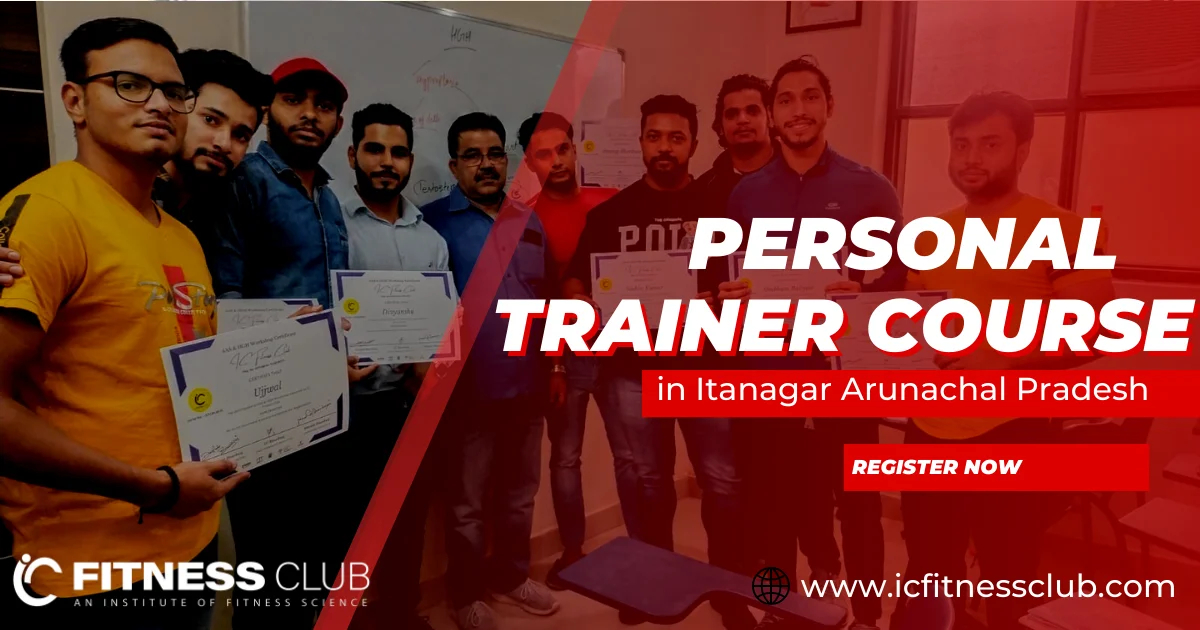Personal Trainer Course in Itanagar Arunachal Pradesh – IC Fitness Club
A Personal Trainer Course is a program or certification course that provides training and education on the principles and practices of personal training. The course typically covers anatomy and physiology, exercise science, nutrition, and the design and implementation of fitness programs for individual clients or small groups.
Upon completion of a Personal Trainer Course, graduates may receive a certificate or credential that demonstrates their knowledge and qualifications as a personal trainer.
IC’s Personal Trainer Course provides comprehensive knowledge of the theoretical as well as Practical Applications.
It is important to note that while a Personal Trainer Course can provide a foundation of knowledge and skills, ongoing education and professional development are essential for personal trainers to stay up-to-date with the latest research, trends, and best practices in the field.
A Personal Trainer Course serves as the foundation for a career as a personal trainer. It provides the basic knowledge and skills needed to become a personal trainer and work with clients. However, it is important to note that the course is just the starting point and ongoing education and professional development are essential for personal trainers to stay current and continuously improve their skills.
In many cases, personal trainers may choose to pursue additional certifications and specializations in areas such as sports performance training, nutrition, or specific populations, such as seniors or athletes. This ongoing education not only demonstrates their commitment to their clients, but also helps them to stay relevant and effective in the rapidly evolving field of personal training.
Syllabus of Personal Trainer Course
IC’s Personal Trainer Course typically covers the following key areas:
- Anatomy and Physiology: This section covers the basic structure and function of the human body, including the musculoskeletal system, cardiovascular system, and nervous system.
- Exercise Science: This section covers the principles of exercise, including the effects of physical activity on the body, the principles of training and adaptation, and the physiological responses to exercise.
- Nutrition: This section covers the basics of nutrition and its role in health and fitness, including macronutrient and micronutrient requirements, energy balance, and the role of nutrition in weight management.
- Assessment and Program Design: This section covers the techniques used to assess a client’s fitness level, identify their goals and needs, and design and implement an effective fitness program.
- Health and Safety: This section covers the principles of injury prevention, emergency procedures, and the safe and effective use of equipment.
- Business and Professional Development: This section covers the skills and knowledge needed to succeed as a personal trainer, including client communication and management, marketing, and ethical and legal considerations.
In addition to these core areas, some Personal Trainer Courses may also include elective modules that cover specialized areas of personal training, such as training for specific populations, sports performance training, or group fitness instruction.
Who can become a Personal Trainer?
Anyone who has a passion for fitness and helping others can pursue a career as a personal trainer. However, there are certain qualifications and requirements that must be met in order to become a personal trainer. These requirements vary by country and jurisdiction, but typically include the following:
- Age: Most personal trainer programs have a minimum age requirement, usually 18 years or older.
- Education: While a high school diploma or equivalent is typically the minimum educational requirement, some personal trainer programs may require a higher level of education, such as a bachelor’s degree in exercise science or a related field.
- Certification: Personal trainers must be certified by a recognized certifying organization, such as the National Academy of Sports Medicine (NASM), the American Council on Exercise (ACE), or the National Strength and Conditioning Association (NSCA).
- Liability Insurance: Personal trainers must have liability insurance to protect themselves and their clients in the event of an injury or accident.
- First Aid and CPR Certification: Personal trainers must have current certification in first aid and CPR to respond in the event of an emergency.
- Physical Fitness: Personal trainers must be in the good physical condition and be able to demonstrate safe and effective exercise techniques.
Where does a personal Trainer works?
The scope for a personal trainer is wide and growing, as more and more people seek to improve their health and fitness through exercise and nutrition. Personal trainers can work in a variety of settings, including:
- Gyms and Health Clubs: This is one of the most common places for personal trainers to work, as gyms and health clubs offer a convenient and well-equipped environment for personal training sessions.
- Studios and Training Centers: Personal trainers can also work in dedicated training centers or studios that specialize in personal training.
- Corporate Wellness Programs: Many companies are now offering wellness programs to their employees, which can provide opportunities for personal trainers to work in a corporate setting.
- Online and Remote Training: With advances in technology, personal trainers can now offer their services online, reaching clients who may not have access to a traditional gym or training center.
- Self-Employment: Personal trainers can also choose to work as independent contractors, setting their own schedules and rates and building their own client base.
In addition to these traditional settings, personal trainers can also specialize in specific areas, such as sports performance training, training for specific populations (e.g. seniors, athletes, etc.), or nutrition coaching, which can increase the scope of their services and enhance their earning potential.
Overall, the demand for personal trainers is increasing, and with the growing awareness of the importance of exercise and nutrition for overall health and well-being, the scope for a personal trainer is expected to continue to grow in the coming years.
To get more details about IC’s Personal Trainer Course, Visit below-





